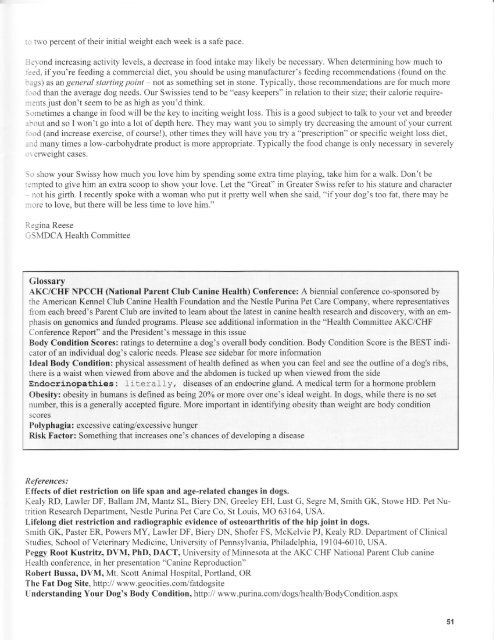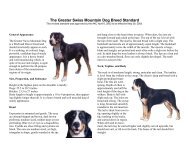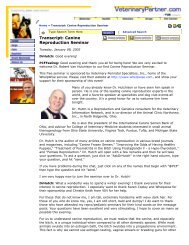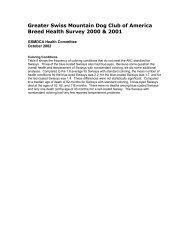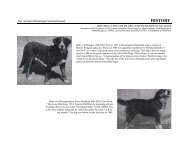Got Ribs? - Greater Swiss Mountain Dog Club of America
Got Ribs? - Greater Swiss Mountain Dog Club of America
Got Ribs? - Greater Swiss Mountain Dog Club of America
Create successful ePaper yourself
Turn your PDF publications into a flip-book with our unique Google optimized e-Paper software.
:-r two percent <strong>of</strong>their initial weight each week is a safe pace.<br />
3e1ond increasing actMty levels, a decrease in food intake may likely be necessary. When determining how much to<br />
::ed, ifyou're feeding a commercial diet, you should be using manufacturer's feeding recommendations (found on the<br />
: :gs) as an general starting point - not as something set in stone. Tlpically, those recommendations are for much more<br />
::od than the average dog needs. Our <strong>Swiss</strong>ies tend to be "easy keepers" in relation to their size; their calorie requirerents<br />
just don't seem to be as high as you'd think.<br />
: -'metimes a change in food will be the key to inciting weight loss. This is a good subject to talk to your vet and breeder<br />
::out and so I won't go into a lot <strong>of</strong> depth here. They may want you to simply try decreasing the amount <strong>of</strong> your current<br />
: -'od (and increase exercise, <strong>of</strong> course !), other times they will have you try a "prescription" or specific weight loss diet,<br />
:rd many times a low-carbohydrate product is more appropriate. Typically the food change is only necessary in severely<br />
:' erweight cases.<br />
: -' show your <strong>Swiss</strong>y how much you love him by spending some extra time playing, take him for a walk. Don't be<br />
::mpted to give him an extra scoop to show your love. Let the "Great" in <strong>Greater</strong> <strong>Swiss</strong> refer to his stature and character<br />
- not his girth. I recently spoke with a woman who put it pretty well when she said, "if your dog's too fat, there may be<br />
:ore to love, but there will be less time to love him."<br />
Legina Reese<br />
ISMDCA Health Committee<br />
Glossary<br />
-{KC/CIIF NPCCH (National Parent <strong>Club</strong> Canine Health) Conference: A biennial conference co-sponsored by<br />
the <strong>America</strong>n Kennel <strong>Club</strong> Canine Health Foundation and the Nestle Purina Pet Care Company, where representatives<br />
tuom each breed's Parent <strong>Club</strong> are invited to leam about the latest in canine health research and discovery with an emphasis<br />
on genomics and funded programs. Please see additional information in the "Health Committee AKC/CIIF<br />
Conference Report" and the President's message in this issue<br />
Body Condition Scores: ratings to determine a dog's overall body condition. Body Condition Score is the BEST indicator<br />
<strong>of</strong>an individual dog's caloric needs. Please see sidebar for more information<br />
Ideal Body Condition: physical assessment <strong>of</strong>health defined as when you can feel and see the outline <strong>of</strong>a dog's ribs,<br />
there is a waist when viewed from above and the abdomen is tucked up when viewed ftom the side<br />
Endocrinopathies: literally, diseases <strong>of</strong>an endocrine gland. A medical term for a hormone problem<br />
Obesity: obesity in humans is defined as being2jo/o or more over one's ideal weight. In dogs, while there is no set<br />
number, this is a generally accepted figure. More important in identiffing obesity than weight are body condition<br />
scores<br />
Polyphagia: excessive eating/excessive hunger<br />
Risk Facfor: Somethingthat increases one's chances <strong>of</strong> developing a disease<br />
References:<br />
Effects <strong>of</strong> diet restriction on life span and age-related changes in dogs.<br />
Kealy RD, Lawler DF, Ballam JM, Mantz SL, Biery DN, Greeley EH, Lust G, Segre M, Smith GK, Stowe HD. Pet Nurrition<br />
Research Department, Nestle Purina Pet Care Co, St Louis, MO 63164, USA.<br />
Lifelong diet restriction and radiographic evidence <strong>of</strong> osteoarthritis <strong>of</strong> the hip joint in dogs.<br />
Smith GK, Paster ER, Powers MY, Lawler DF, Biery DN, Sh<strong>of</strong>er FS, McKelvie PJ, Kealy RD. Department <strong>of</strong> Clinical<br />
Studies, School <strong>of</strong>Veterinary Medicine, University <strong>of</strong>Pennsylvania, Philadelphia, 19104-6010, USA.<br />
Peggy Root Kustritz, DVM, PhD, DACT, University <strong>of</strong> Minnesota at the AKC CHF National Parent <strong>Club</strong> canine<br />
Health conference, in her presentation "Canine Reproduction"<br />
Robert Bussa, DVM, Mt. Scott Animal Hospital, Portland, OR<br />
The Fat <strong>Dog</strong> Site, http:// www.geocities.com/fatdogsite<br />
Understanding Your <strong>Dog</strong>'s Body Condition, http:// www.purina.com/dogs/health,tsodyCondition.aspx<br />
51


